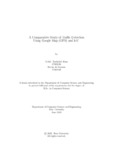| dc.contributor.advisor | Kazi, Sadia Hamid | |
| dc.contributor.advisor | Shakil, Arif | |
| dc.contributor.author | Alam, Mohd. Touhedul | |
| dc.contributor.author | Al Nayeem, Harun | |
| dc.date.accessioned | 2023-12-21T06:04:28Z | |
| dc.date.available | 2023-12-21T06:04:28Z | |
| dc.date.copyright | 2021 | |
| dc.date.issued | 2021-06 | |
| dc.identifier.other | ID: 17301230 | |
| dc.identifier.other | ID: 17301209 | |
| dc.identifier.uri | http://hdl.handle.net/10361/22020 | |
| dc.description | This thesis is submitted in partial fulfillment of the requirements for the degree of Bachelor of Science in Computer Science, 2021. | en_US |
| dc.description | Cataloged from PDF version of thesis. | |
| dc.description | Includes bibliographical references (pages 39-41). | |
| dc.description.abstract | Everyone knows that time is money and nowadays people spend quite a large amount
of time on the roads in their daily life. The reason behind this is nothing but
‘Traffic’. Traffic detection and navigation has gone through many phases over the
years. Once we had to depend on traffic prediction and now, we can check real time
traffic updates by the means of services like Google Map. Google Map uses GPS to
detect traffic. However, the problem with it is, Map uses historical traffic data and
the individual GPS device count to detect the congestion of traffic. This may affect
the accuracy in terms of vehicles. Depending only on the device count and past
records, a proper real time data cannot be generated. The very important aspect of
vehicle count, and vehicle size are totally ignored in this approach. Moreover, a real
time representation of traffic will also require 24/7 surveillance. Another promising
approach to detect traffic is using IoV (Internet of Vehicles) to count the number of
connected vehicles rather than counting people in an area. As the world is moving
towards IoT, traffic detection can evolve to a great extent with the introduction of
IoV as well. In this work, we will be analysing the existing system google uses for
traffic detection and compare it with a possible model to be used with the inclusion
of IoV. To provide a verdict on which system will be better, we will be using traffic
detection reports of google Map as preliminary data and possible outcome of the
IoV model analysed. | en_US |
| dc.description.statementofresponsibility | Mohd. Touhedul Alam | |
| dc.description.statementofresponsibility | Harun Al Nayeem | |
| dc.format.extent | 41 pages | |
| dc.language.iso | en | en_US |
| dc.publisher | Brac University | en_US |
| dc.rights | Brac University theses are protected by copyright. They may be viewed from this source for any purpose, but reproduction or distribution in any format is prohibited without written permission. | |
| dc.subject | Traffic detection | en_US |
| dc.subject | Google map | en_US |
| dc.subject | IoV | en_US |
| dc.subject | GPS | en_US |
| dc.subject | Navigation | en_US |
| dc.subject.lcsh | Computer communication systems. | |
| dc.title | A comparative study of traffic detection using Google map (GPS) and IoV | en_US |
| dc.type | Thesis | en_US |
| dc.contributor.department | Department of Computer Science and Engineering, Brac University | |
| dc.description.degree | B.Sc. in Computer Science | |

